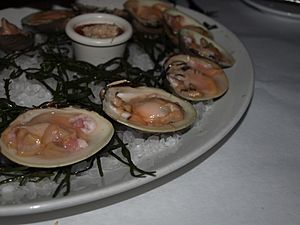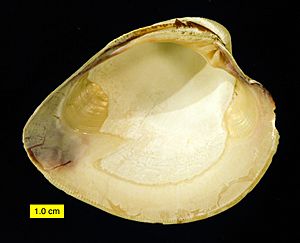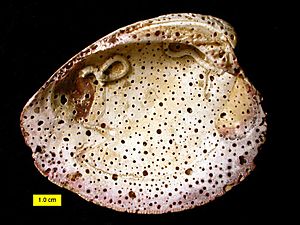Hard clam facts for kids
Quick facts for kids Hard clam |
|
|---|---|
 |
|
| Scientific classification |
The hard clam (Mercenaria mercenaria) is a type of clam that lives in the ocean. It's also known by names like quahog, round clam, or hard-shell clam. These clams are edible, meaning people can eat them! They are found along the eastern coasts of North America and Central America, from Prince Edward Island in Canada all the way down to the Yucatán Peninsula in Mexico.
Hard clams are a type of bivalve mollusk. Bivalves are sea creatures with two shells that are hinged together, like oysters and mussels. Sometimes, people just call them "clams" when they talk about digging for them. You might also see them called Venus mercenaria in older books, as they belong to the Veneridae family, which are known as venus clams.
It's important not to confuse the hard clam with the "ocean quahog" (Arctica islandica). Even though they look a bit similar, they are different species. The ocean quahog is usually rounder and has a black outer layer on its shell.
Contents
Different Names for Hard Clams
The hard clam has many different names! Besides hard clam, it's also called the Northern quahog, round clam, or chowder clam.
When you go to a fish market, you might hear even more specific names based on the clam's size:
- The smallest clams that can be caught are called countnecks or peanuts.
- The next size up are littlenecks.
- Then come topnecks.
- Larger ones are called cherrystones.
- The biggest clams are known as quahogs or chowder clams.
The name quahog (pronounced KOH-hog or KWAW-hog) is quite special. It comes from the word "poquauhock" in the Narragansett language, which is an old Native American language. This name was first used in English in North America in 1794. Native American tribes, like the Narragansett, used the shells of these clams to make valuable beads called wampum, especially from the purple parts of the shell. This is why the clam's scientific name, mercenaria, is related to the Latin word for trade or commerce. People living along the coast of New England still use the Native American word "quahog" today, just as they have for hundreds of years.
Sometimes, clam farmers grow special types of hard clams. These clams look very much like regular "wild" clams, but their shells might have unique markings. These are known as the notata strain of quahogs.
Where Hard Clams Live
Hard clams are very common in New England, stretching north into Canada, and all the way down the Eastern coast of the United States to Florida. They are especially plentiful between Cape Cod and New Jersey. In these areas, growing and harvesting clams is a big business called aquaculture. For example, hard clams are an important part of the sea life in the lower Chesapeake Bay.
Rhode Island is a major area for quahogs. It has provided about a quarter of all the quahogs caught for sale in the U.S.! Because of this, the quahog is the official shellfish of Rhode Island. Hard clams have also been moved to new places, like the Pacific coast of North America, Great Britain, and other parts of Europe, where they are now farmed. They reproduce by releasing tiny reproductive cells called gametes into the water.
Health Issues: Quahog Parasite Unknown (QPX)
Hard clams can sometimes get sick from a tiny organism called Quahog Parasite Unknown (QPX). This parasite affects the hard clam Mercenaria mercenaria. Scientists are still learning a lot about QPX. This research is important for clam farmers, who can lose a lot of money when their clams die from this disease. When clams get QPX, they might develop blisters on their soft body parts and eventually die.
QPX was first found along the coast of Cape Cod, Massachusetts, in 1995. The QPX parasite is a type of protist, which is a very simple organism. While many protists live in the ocean without causing harm, only a few are known to be parasites of marine animals. QPX disease was first noticed in Canada in the early 1960s. However, it became a much bigger problem for farmed clams in Prince Edward Island, Massachusetts, in 1992, and in Virginia in 1997.
How People Use Hard Clams

In coastal areas like New England, New York, and New Jersey, you can find restaurants called raw bars. These places often serve littlenecks and topnecks raw on the half-shell. People usually eat them with cocktail sauce and lemon. Sometimes, littlenecks are steamed and dipped in butter.
Smaller clams like littlenecks are often used in sauces, soups, and stews. They can also be found in dishes like clams casino. The biggest clams, quahogs or chowder clams, and cherrystones, have tougher meat. These are often used in dishes like clam chowder, clam cakes, and stuffed clams. They can also be chopped up and mixed into dishes that use smaller, more tender clams.
Historically, Native Americans used quahogs for food and to make wampum. The Narragansetts, for example, used hard clams for both eating and creating beautiful ornaments.
Interestingly, a group of hard clams now lives in Southampton Water in Hampshire, England. They were originally brought there to be raised in the warm water from a power station. These clams were meant to be used as bait for eels. However, they started reproducing on their own and now live in Southampton Water and have even spread to other harbors nearby.
Clams and Red Tide
The term "red tide" refers to something serious that can happen in the ocean. It's when harmful toxins, like saxitoxin, build up. These toxins are made by tiny ocean plants called marine algae. Filter-feeding shellfish, like clams, oysters, and mussels, can absorb these toxins from the water.
If people eat shellfish that have absorbed these toxins, it can be very dangerous, even deadly. The toxins affect the human central nervous system. Sometimes, these algal blooms can make the seawater look red, but not always. Also, despite the name, "red tide" has nothing to do with ocean tides.
See also
 In Spanish: Almeja americana para niños
In Spanish: Almeja americana para niños




